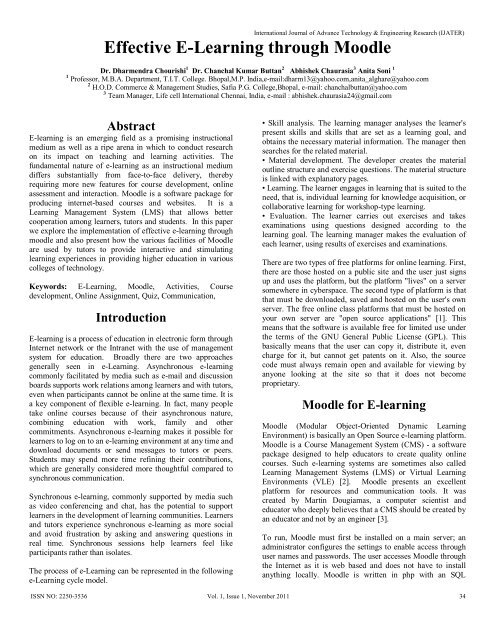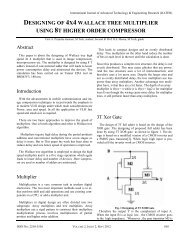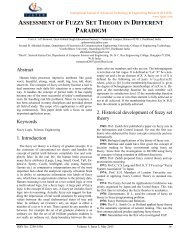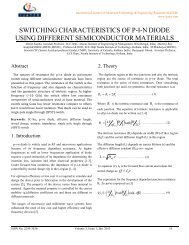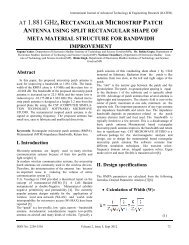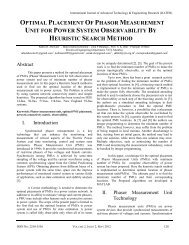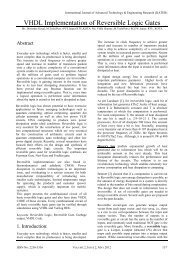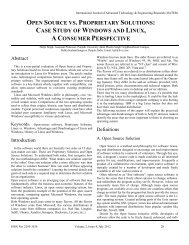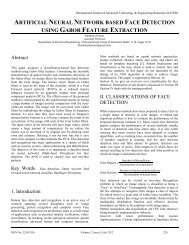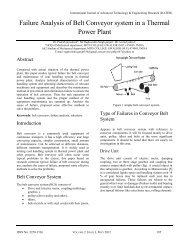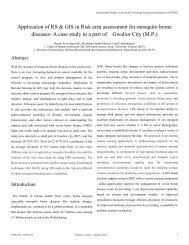Effective E-Learning through Moodle - ijater
Effective E-Learning through Moodle - ijater
Effective E-Learning through Moodle - ijater
Create successful ePaper yourself
Turn your PDF publications into a flip-book with our unique Google optimized e-Paper software.
International Journal of Advance Technology & Engineering Research (IJATER)<strong>Effective</strong> E-<strong>Learning</strong> <strong>through</strong> <strong>Moodle</strong>Dr. Dharmendra Chourishi 1 Dr. Chanchal Kumar Buttan 2 Abhishek Chaurasia 3 Anita Soni 11 Professor, M.B.A. Department, T.I.T. College. Bhopal,M.P. India,e-mail:dharm13@yahoo.com,anita_alghare@yahoo.com2 H.O.D. Commerce & Management Studies, Safia P.G. College,Bhopal, e-mail: chanchalbuttan@yahoo.com3 Team Manager, Life cell International Chennai, India, e-mail : abhishek.chaurasia24@gmail.comAbstractE-learning is an emerging field as a promising instructionalmedium as well as a ripe arena in which to conduct researchon its impact on teaching and learning activities. Thefundamental nature of e-learning as an instructional mediumdiffers substantially from face-to-face delivery, therebyrequiring more new features for course development, onlineassessment and interaction. <strong>Moodle</strong> is a software package forproducing internet-based courses and websites. It is a<strong>Learning</strong> Management System (LMS) that allows bettercooperation among learners, tutors and students. In this paperwe explore the implementation of effective e-learning <strong>through</strong>moodle and also present how the various facilities of <strong>Moodle</strong>are used by tutors to provide interactive and stimulatinglearning experiences in providing higher education in variouscolleges of technology.Keywords: E-<strong>Learning</strong>, <strong>Moodle</strong>, Activities, Coursedevelopment, Online Assignment, Quiz, Communication,IntroductionE-learning is a process of education in electronic form <strong>through</strong>Internet network or the Intranet with the use of managementsystem for education. Broadly there are two approachesgenerally seen in e-<strong>Learning</strong>. Asynchronous e-learningcommonly facilitated by media such as e-mail and discussionboards supports work relations among learners and with tutors,even when participants cannot be online at the same time. It isa key component of flexible e-learning. In fact, many peopletake online courses because of their asynchronous nature,combining education with work, family and othercommitments. Asynchronous e-learning makes it possible forlearners to log on to an e-learning environment at any time anddownload documents or send messages to tutors or peers.Students may spend more time refining their contributions,which are generally considered more thoughtful compared tosynchronous communication.Synchronous e-learning, commonly supported by media suchas video conferencing and chat, has the potential to supportlearners in the development of learning communities. Learnersand tutors experience synchronous e-learning as more socialand avoid frustration by asking and answering questions inreal time. Synchronous sessions help learners feel likeparticipants rather than isolates.The process of e-<strong>Learning</strong> can be represented in the followinge-<strong>Learning</strong> cycle model.• Skill analysis. The learning manager analyses the learner'spresent skills and skills that are set as a learning goal, andobtains the necessary material information. The manager thensearches for the related material.• Material development. The developer creates the materialoutline structure and exercise questions. The material structureis linked with explanatory pages.• <strong>Learning</strong>. The learner engages in learning that is suited to theneed, that is, individual learning for knowledge acquisition, orcollaborative learning for workshop-type learning.• Evaluation. The learner carries out exercises and takesexaminations using questions designed according to thelearning goal. The learning manager makes the evaluation ofeach learner, using results of exercises and examinations.There are two types of free platforms for online learning. First,there are those hosted on a public site and the user just signsup and uses the platform, but the platform "lives" on a serversomewhere in cyberspace. The second type of platform is thatthat must be downloaded, saved and hosted on the user's ownserver. The free online class platforms that must be hosted onyour own server are "open source applications" [1]. Thismeans that the software is available free for limited use underthe terms of the GNU General Public License (GPL). Thisbasically means that the user can copy it, distribute it, evencharge for it, but cannot get patents on it. Also, the sourcecode must always remain open and available for viewing byanyone looking at the site so that it does not becomeproprietary.<strong>Moodle</strong> for E-learning<strong>Moodle</strong> (Modular Object-Oriented Dynamic <strong>Learning</strong>Environment) is basically an Open Source e-learning platform.<strong>Moodle</strong> is a Course Management System (CMS) - a softwarepackage designed to help educators to create quality onlinecourses. Such e-learning systems are sometimes also called<strong>Learning</strong> Management Systems (LMS) or Virtual <strong>Learning</strong>Environments (VLE) [2]. <strong>Moodle</strong> presents an excellentplatform for resources and communication tools. It wascreated by Martin Dougiamas, a computer scientist andeducator who deeply believes that a CMS should be created byan educator and not by an engineer [3].To run, <strong>Moodle</strong> must first be installed on a main server; anadministrator configures the settings to enable access <strong>through</strong>user names and passwords. The user accesses <strong>Moodle</strong> <strong>through</strong>the Internet as it is web based and does not have to installanything locally. <strong>Moodle</strong> is written in php with an SQLISSN NO: 2250-3536 Vol. 1, Issue 1, November 2011 34
database. <strong>Moodle</strong> has updates installed from time to time andso it is continually being modified and enhanced.<strong>Moodle</strong> is a template-based system to which content must beadded. This makes <strong>Moodle</strong>'s interface very intuitive andallows for easy navigation. The whole page is presented in a"flat view" format. It is laid out in small blocks and organizedaround sections following a topic or weekly outline. Eachsection has its own tools such as lessons, quizzes,assignments, and forums. All blocks on a page can beindividually arranged, and the elements within each sectioncan be easily moved around or be hidden [4].Technical Requirements<strong>Moodle</strong> being Open Source is not limited to a particular set oftechnical requirements but can be installed on most CPU’swhether they are old or new models, making it very dynamic[5].Hardware platforms: Windows 95, 98, 2000, NT, orME/ XP/ Vista/ Pentium2-3/ MAC 9/ OS X. Thismeans it can be used by practically anyone. The screen resolution may be set to either 800x 600or higher to 1024 x 768.Internet connection may be via a simple 56k modemor a high speed ADSL /Cable connection.Internet Browsers can vary from Mozilla Firefox,Internet Explorer. Opera and Safari browsers will notdisplay the built-in HTML editor.Most applications can be opened and used in <strong>Moodle</strong>eg. Microsoft Word, Excel and PowerPoint. TheExcel viewer and PowerPoint viewer work as well aswill a simple word processor. Open Office can beused as an alternative.Supports multimedia Plugins that include: WindowsMedia Player, RealPlayer, Apple Quicktime, Acrobatreader, Flash player, Shockwave player, JavaApplets, Java Mac OSxInternational Journal of Advance Technology & Engineering Research (IJATER)requires the teacher to enroll each student directly one by one.In this mode the teacher has full control in adding or removingstudents. Both enrolment and expulsion are done <strong>through</strong> asimple interface that can be accessed <strong>through</strong> the participantlink on the homepage. It shows a list of all valid users on thesystem and the list of current students. The fourth option usesan enrolment key set by the teacher. The teacher must sharethis key with all his students. Students must provide this keyon their first entry to enroll them in the course. If the key isvalid, the enrolment is complete, and further access does notrequire the key. Once all students are enrolled, it is better tochange the enrolment key to prevent misuse. If any 'unwanted'student enters the course, the teacher can expel him asmentioned earlier. All these operations can be done bychoosing the “settings” option in moodle course page.Fig.1 The screen shot of basic operationsUser Types and Access mechanismAfter the installation of moodle, we can get an administratoraccount and its password. With this account we can createcourses, add users to the system, and manage other systemfunctions. <strong>Moodle</strong> uses a role based access mechanism, andimplements three major roles: administrator, teacher, andstudent. A user can be given any of these roles. A user can bea student in one course, and a teacher for another. A teachercan also be the system administrator. Only those with anadministrator role can control and create courses or assignteacher role to others or assign administrator role to any oneelse. When a user enrolls in a particular course then thestudent role will be given.<strong>Moodle</strong> provides four types of access mechanism for studentsto join a course. The simplest method requires noauthentication and allows any user to join the course. Thesecond is a guest user mode where the user can go <strong>through</strong> thecourse, but cannot participate in any activity. The third modeBasic Features and OperationsThe basic features of moodle include tools for creatingresources and activities [6]. These in turn provide the tutormanaging the course with various useful options as shown infig.1. The Resources tab offers the tutor a choice of creatinglabels which are simply headings for each topic or week,creating text pages or web pages with a combination of text,images and links, creating links to files or web sites/pageswhich can link to videos and other files, creating directorieswhich are folders. Another useful and collaborative section isthe Activities tab which includes: assignments, chat, andchoice (one question with a choice of answers – answers arelogged so statistics can be deducted), database which is a tablecreated by the tutor and filled in by the students. Forum whereeveryone can post in response to discussion threads, glossary atype of dictionary created by the tutor with terms used andtheir meanings. Lessons offer the flexibility of a web page, theinteractivity of a quiz and branching capabilities. Quiz enablesthe creation of various types of quizzes, survey is aquestionnaire which gathers feedback from students, and wikiISSN NO: 2250-3536 Vol. 1, Issue 1, November 2011 35
is a web page edited collaboratively. SCORM is a tool forenabling SCORM packages into the content that is packagedcontent which can be used on any Virtual <strong>Learning</strong>Environment. For a tutor to configure some basic settingsbefore adding actual content there is a settings button in theadministration block on the course page. Here one can selectthe format of the course, layout, number of weeks or topicsand set the maximum upload size amongst others. Enrolmentsettings are accessed from here as well as availability andlanguage. Roles can be administered giving different peopledifferent types of access.Course ManagementThere are three different formats for the course – Weekly,Social and Topic. The weekly format organizes the course intoweeks, with assignments, discussion boards, tests, etc, allresiding in a week-by-week block [7]. The Social format isbuilt around a forum, which is good for announcements anddiscussions. The Topic format organizes everything by topics,regardless of how long they are. Our courses are in topicformat. They are used for e-learning by our students, who usethe resources by logging into the college web sitehttp://www.ctshinas.edu.om and the choosing the link e-learning.The class notes can include lecture slides, documents in anyformat (PDF, HTML, DOC, etc), videos, audios, animations,graphics, etc in the content. Depending on the format chosen,we can organize the content topic wise or class schedule wise.Content can have different sub titles such as introduction,overview, survey, illustrations, animations, discussions, etc.Content must be prepared to ensure that there is something ofinterest to the weakest in the class and the brightest. Contentshould be visual and interactive and not heavily textual. The'add resource' link on each block provides a range of optionsfor adding content. File upload, hyperlink to web pageselsewhere as well as provision to create own web pages areprovided [fig.2]. Course management can be changed byteacher and administrator. They have full control over allsettings for a course, including restricting other teachers.International Journal of Advance Technology & Engineering Research (IJATER)Fig.2 The screen shot of course managementInteractionThe effectiveness of the e-learning system depends on thelevel of interaction provided among the students and tutors. Inmoodle all announcements relating to the course are made<strong>through</strong> news forum. We can add such discussion forums<strong>through</strong> the 'add activity' link in each block. Forums are quiteversatile interaction and learning devices, when used carefully.We can ensure that comments and participation from studentsare responded <strong>through</strong> appreciation, relevant countercomments, constructive suggestions, etc. Being an unfamiliarmedium, these little gestures go a long way to make thestudents feel comfortable. One could also consider givingcredit to participation in forums as part of the internalassessment, to further drive up the interest. <strong>Moodle</strong> has othercommunication mechanisms such as chat, mail, etc as well.We can set up the discussion board so that if anyone posts aresponse to our post, we can get an email. This can be used toremind us to check the system as and when there is somethinghappening, instead of polling the system frequently lookingfor updates.The teachers can pose questions for discussion, encouragestudents to ask questions online and respond online. This, notonly serves as a repository of interaction that other studentscan refer and use, it also encourages further interaction amongstudents, clarifying and enhancing the discussion. Posing selftest questions on major sections of the course is also useful asa feedback to the students.QuizQuiz module allows the tutor to design and set quiz tests. Eachquestion has a category. When we create a new question, it isstored in the selected category and these categories can be"published" to make them accessible from any course on thesite. To create a new question, we must select the type ofquestion from the pull-down menu. We have the option ofadding, which includes: Multiple choice questions; True/Falsequestions; A short answer question; A numerical question;Matching question; Description question; Random set;Random short answer; These questions are kept in acategorized database, and can be re-used within courses andeven between courses. Quiz module includes gradingfacilities. Quizzes are automatically graded, and can be regradedif questions are modified. As shown in fig.3 quizzescan have a limited time window outside of which they are notavailable. Quiz questions and quiz answers can be shuffled toreduce cheating. Questions allow HTML and images.Questions can be imported from external text files. Quizzescan be attempted multiple times, if desired. Attempts can becumulative, if desired, and finished over several sessions.We can make use of the question banking facility to build arepository of questions on the subject. This will be helpful toISSN NO: 2250-3536 Vol. 1, Issue 1, November 2011 36
keep questions updated based on feedback, to vary thequestions in the quizzes from year to year, and even inpreparing university or class examination papers from time totime.International Journal of Advance Technology & Engineering Research (IJATER)AssignmentAssessments in any learning scenario plays a number of majorroles in giving feedback to the student on where they standwith respect to the subject objectives and with respect to theclass as a whole, and to the tutor on how effective the teachinghas been.For the online submission of assignments we can use the'assignment' option in the activity menu in the block for settingup an assignment. In moodle assignments can be specifiedwith a due date and a maximum grade. Students can uploadtheir assignments in any file format to the server where theyare date-stamped. The use of a small enough file upload sizewill prevent large files from being uploaded choking thesystem. Late assignments are allowed, but the amount oflateness is shown clearly to the tutor. For each particularassignment, the whole class can be assessed (grade andcomment) on one page in one form. Tutor’s feedback isappended to the assignment page for each student, andnotification is mailed out. The tutor can choose to allowresubmission of assignments after grading for doing theregarding.These assignments may be posed as simply feedback devices –not carrying any weightage towards the final score – or as apart of the subject evaluation scheme. In the former, the tutorhas more freedom in posing questions and number of suchassignments posed, but the response may be lower sincestudents may not see any direct benefit.Fig.3 The screen shot of quiz moduleSystem ProtectionAny kind of automation brings with it associated dangers.Computer systems are known for virus attacks, spams,hackers, etc. We can make sure that the <strong>Moodle</strong> server iswell protected <strong>through</strong> usual security provisions in thenetwork. The following points must be considered toincrease the protection. Minimize the number of users with administrator roleto reduce risk to the system. Take periodic backup of the courses. Courses can bepackaged as a single zip file using the Backupfunction. These can be restored on any <strong>Moodle</strong> server[fig.4]. Once the admission is over, set the enrolment modeas <strong>through</strong> the key, and set the key to some difficultto guess string. It will prevent unwanted users gettingaccess to the course. Specify upload limits that are reasonable wherever astudent is permitted to upload a file.ISSN NO: 2250-3536 Vol. 1, Issue 1, November 2011 37
International Journal of Advance Technology & Engineering Research (IJATER)3. Teacher Manual, (2004),http://moodle.org/mod/resource/view. php?id=3864.4. Williams, Bryan, (Sep 1, 2005)<strong>Moodle</strong> 1.4.3 For Teachers& Trainers, http://moodle.org/file.php/29/English_Manuals/<strong>Moodle</strong>_1.4.3_For_Teachers_ and_Trainers.pdf5. http://www.moodle.org6. Terherst, Adrienne, (May 2, 2005), New System <strong>Moodle</strong>More <strong>Effective</strong>7. Branzburg, Jeffrey, (Aug 15, 2005), How To: Use the<strong>Moodle</strong> Course Management System,http://www.techlearning.com/story/showArticle.jhtml?articleID=168600961.Fig.4 The screen shot course backup facilityConclusionsIn this paper we have examined various supports offered by<strong>Moodle</strong> for E-learning. <strong>Moodle</strong> is a great tool for tutorsbecause it is a platform to create and save teaching materialeasily and a collaborative online platform for teachers andstudents to learn together. Besides creating courses, it is alsovery useful to join the online communities to keep yourselfupdated with the world and to know a circle of scholars thatwill truly encircle the globe. On moodle.org website we caneasily find a lot of modules, which are very useful to extendour <strong>Moodle</strong> site with them. These tools help us to maketeaching more effective. Thus the implementation of theinformation and communication technology in education withe-learning <strong>through</strong> moodle allows improving effectiveness ofthe education. E-learning allows better cooperation among thelearners, the tutors and the students. The accessibility,usability and student collaborative learning can be improvedand higher motivation among the students and the teachers canbe achieved with E-learning.References1. Nag, Aditya, (May 24, 2005), <strong>Moodle</strong>: An open sourcelearning management system.2. Kameron, Saskia E., A Review of Free Online <strong>Learning</strong>Management Systems (LMS), TESL-EJ, ISSN 1872-4303,vol.7, No.2, M-2, http://www-writing.berkeley.edu/TESL -EJ/ej26/m2.html.ISSN NO: 2250-3536 Vol. 1, Issue 1, November 2011 38


